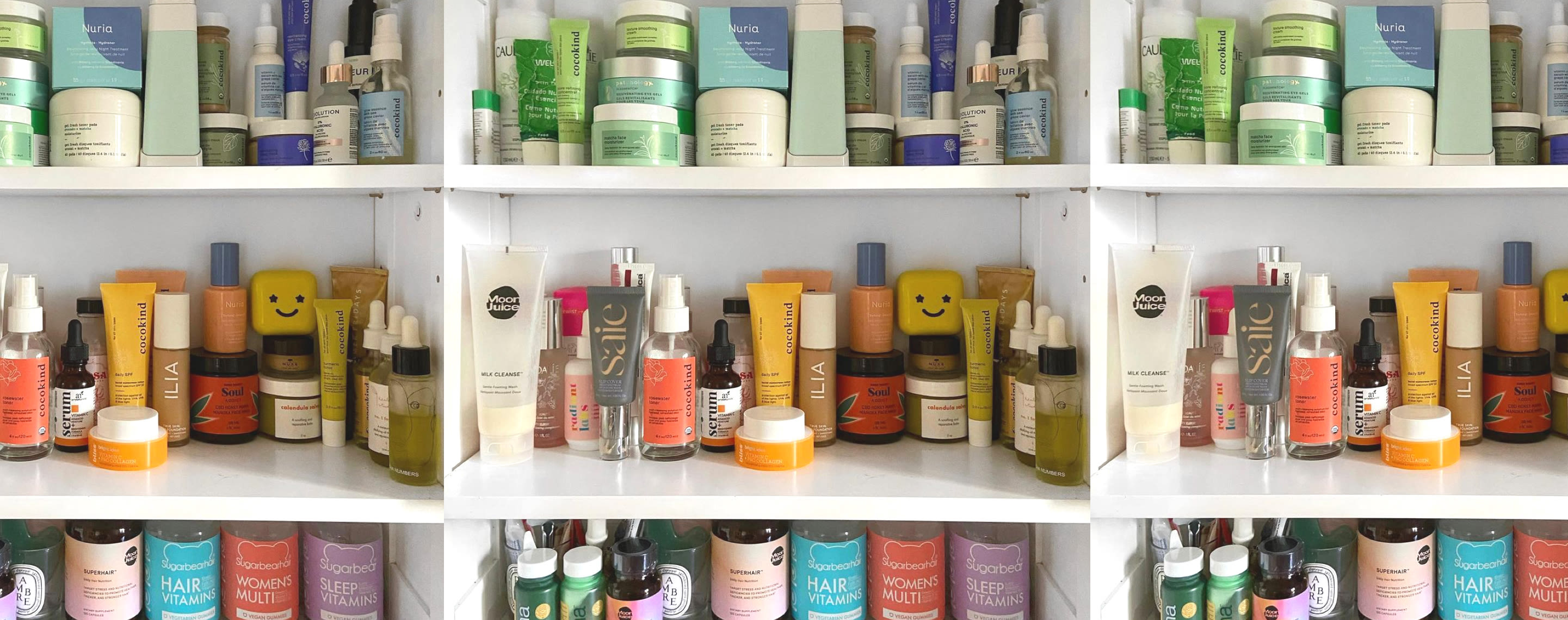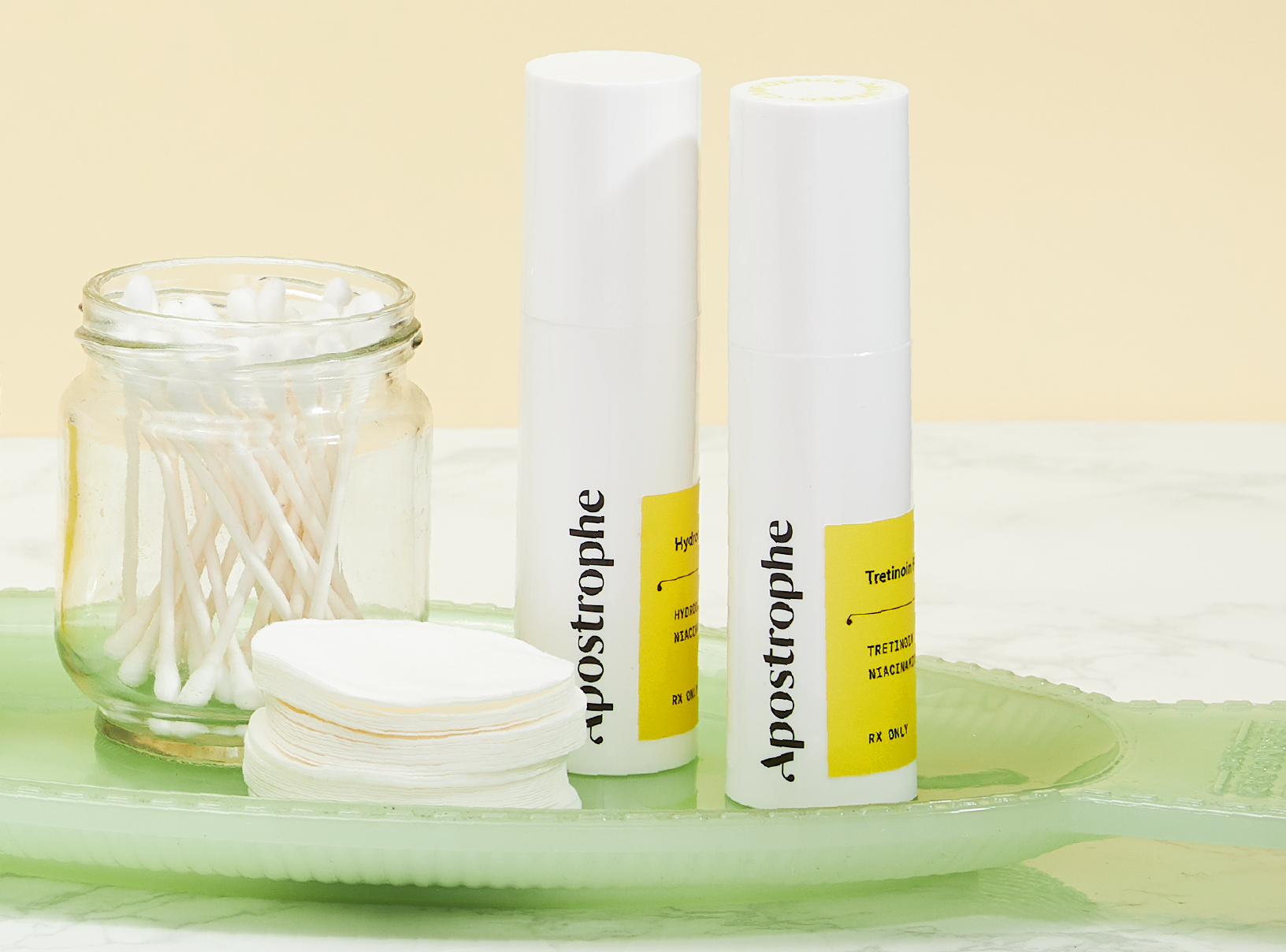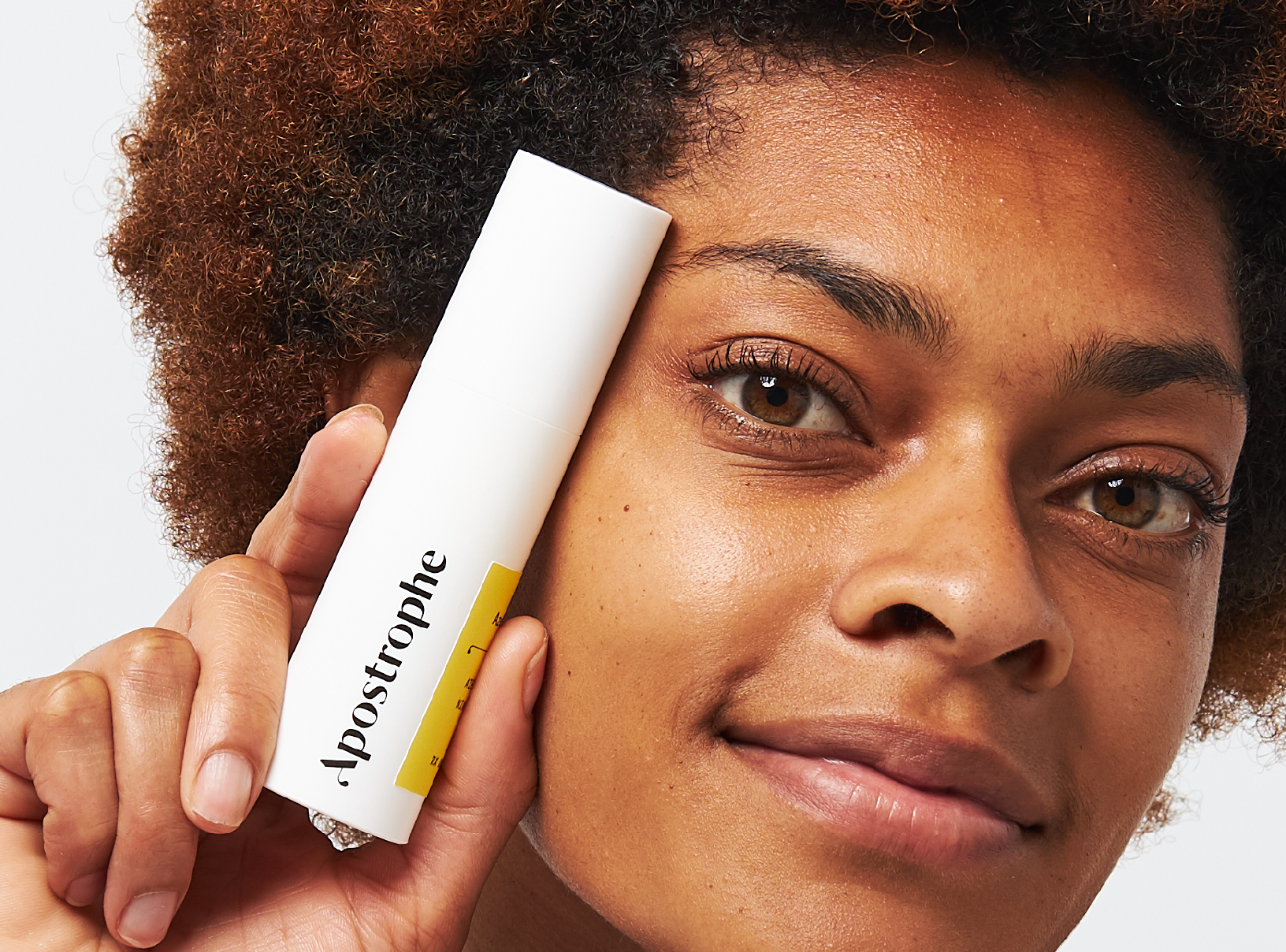Education
How to build a face care routine


SHARE
Education
How to build a face care routine
Medically reviewed by Jill Johnson, DNP, APRN, FNP-BC
Written by Apostrophe Team
Last updated 11/3/2024
Youthful, clear, glowy skin — sounds ideal, right? But getting the skin of your dreams can be a bit more complicated than simply wishing for it.
One thing that can help: Establishing a solid skin care routine and sticking to it!
But before you dive into solidifying a routine, there are a few other things you need to understand first — like your skin type and what ingredients will work best for you.
Don’t worry, it’s a lot less complicated than it sounds.
It’s Important to Know Your Skin Type
Understanding what type of skin you have can help you determine the types of products you need and what steps should be incorporated into your routine.
There are three skin types, with a couple of additional ones sometimes thrown into the mix. Read on to see which sounds the most like yours.
Clinically speaking, these are the three most commonly referenced skin categories:
Dry: Defined as flaky, itchy, or rough, dry skin needs moisture.
Oily: This is your skin type if you notice your skin is often shiny and greasy to the touch.
Combination: If areas of your skin are dry and other parts are oily, you have combination skin.
Then, after you get through oily, dry, and combination, there are two other skin types that dermatology professionals sometimes throw into the mix to help patients better figure out what kind of skincare routine would be optimal.
They are:
Sensitive: This is a bit different than the other types because it’s less about how your skin looks or feels and more about how it reacts. Sensitive skin may sting or burn after using certain products.
Normal: Neither oily nor dry, normal skin tends to be clear and well-balanced. It’s also not sensitive.
So, which skin type do you have? Once you know, it’s fairly easy to ascertain what your skin likely needs.
For example, if you have dry skin, hydration should be a primary goal.
While those with oily skin may want to focus on keeping pores unclogged. You get the idea.
The Types of Products to Consider For Your Routine
Whether you’re walking down the skin care aisle at a local store or shopping online, the options can be pretty overwhelming.
Consider this your cheat sheet on what may work best for your skin.
Cleanser
If you want your other products to absorb properly, it’s key to start with a clean base.
Additionally, research has found that using a high-quality cleanser can keep skin healthy and reduce acne.
Look for a gentle, non-abrasive face wash that doesn’t contain alcohol (which can be drying). Another thing to look for?
One that is labeled “non-comedogenic,” which means it won’t clog pores.
Moisturizer
No matter your skin type, using a moisturizer is an essential part of a good skin care routine.
Your skin actually has a way of hydrating itself through your sebaceous glands, which naturally secrete oil to keep your skin lubricated and maintain a protective barrier.
However, throughout the day, that barrier is worn away by sun and pollution. That’s why using a moisturizer is so important.
You may think that if you have oily skin, you can skip moisturizer. Wrong. If you let your skin get dry, it sends a signal to your body to produce even more oil.
But if you do have oily or acne-prone skin, you will want to choose a moisturizer that is oil-free and non-comedogenic. When you’re shopping, look for moisturizers with these ingredients:
Alpha Hydroxy Acid
Lactic Acid
Glycerin
Jojoba Oil
Sunscreen
You may like how you look when you’re tanning, but in the long run, tanning is a bad idea.
First, there's skin cancer to consider.
Beyond that, sun damage can cause wrinkles. Research has found that UV exposure may reduce elastic properties in the skin, which causes it to sag and wrinkle.
Because of this, adding SPF to your daily routine is key — no matter what the weather is like outside. Even if it’s cloudy, the sun’s harmful rays can penetrate your skin.
The American Academy of Dermatology recommends a broad-spectrum formula (meaning it protects from UVA and UVB rays) and a minimum of SPF 30.

HYPERPIGMENTATION TREATMENT
Target dark spots and hyperpigmentation with customized prescription treatment.
Serums and Anti-Aging Treatments
While a serum isn’t necessarily a must in your routine, it’s a great bonus product that can really help your complexion.
Serums are highly concentrated and formulated to address specific skin issues — like dryness, dullness, age spots, wrinkles, and more.
If you want to address aging skin, look for a serum with vitamin C (which also helps dark spots), vitamin E, ferulic acid, tea polyphenols or resveratrol — or a combination of a few of these.
Dealing with dryness? Try a formula with vitamin E, niacinamide or glycolic acid.
Because serums can be potent, it’s a good idea to test them on a small patch of skin before using them all over.
Likewise, creams made specifically for aging skin can help improve texture and reduce fine lines.
For maximum benefits, go with a prescription-grade anti-aging treatment.
Because these types of creams are often very potent, a healthcare professional will usually suggest you begin using one just a few days a week before building up to every day.
Eye Cream
Want to address wrinkles around your eyes? A clinical trial found that the use of an eye cream for at least four weeks improved the appearance of wrinkles.
Before you purchase, take a look at the ingredient list to ensure you’re buying a product that will be effective.
Vitamin C has been found to reduce visible signs of aging. Another study found that caffeine and vitamin K can help with dark under eye circles.
Acne Treatments
If you’re prone to acne, incorporating an acne treatment into your routine is the way to go. They’re made with a variety of ingredients.
If you have mild acne, over-the-counter spot treatments made with benzoyl peroxide or salicylic acid may be able to help.
If your acne is more severe, prescription strength ingredients like tretinoin or clindamycin are worth considering.
What to Do And When to Do It
There are two times of day when you should really be focusing on your skincare regimen — morning and night.
In the morning your goal is to hydrate and protect. Before leaving the house, here’s a basic outline of what you want to do:
Cleanse: Wet your face with lukewarm water and, with your fingertips, gently massage a gentle cleanser that’s good for your skin type all over. Rinse and softly pat your skin dry.
Moisturize: Hydrate your skin to lock in moisture.
Protect: Before leaving the house, add a layer of SPF 30 all over your face, neck, and chest.
At night, you’ll follow a similar order but your routine can be a bit more in depth. Your focus should be on repairing damage.
In the evening, your skin is also primed for absorption, so products will sink in a bit better.
Remove makeup and cleanse: Take off your makeup and use a gentle cleanser to remove any residual impurities.
Acne treatment: If you’ve got blemishes you’re dealing with, you want to smooth on your acne treatment before any other product so it’s absorbed first.
Serum, anti-aging treatment, eye cream: Next up, apply products to address any other skin issues.
Moisturizer: At night, use a richer hydrating cream than you do in the morning — your skin has more time to absorb it.
Mastering Your Face Care Routine
Getting into a steady face routine can get your complexion in top shape.
While there is no one routine that will work for everyone, following the general tips outlined above is a good place to start.
Remember, the sooner you start taking proper care of your skin, the sooner it will look glowy and youthful.
Sources:
Rodan, K., Fields, K., Majewski, G., Falla, T., (2016, December). Skincare Bootcamp: The Evolving Role of Skincare. PRS Global Open, 4(12 Suppl): e1152. https://www.ncbi.nlm.nih.gov/pmc/articles/PMC5172479/
Skin Care Tips Dermatologists Use. American Academy of Dermatology Association. https://www.aad.org/public/everyday-care/skin-care-basics/care/skin-care-tips-dermatologists-use
Isoda, K., Seki, T., Inoue, S., et al. (2015, February). Efficacy of the combined use of a facial cleanser and moisturizers for the care of mild acne patients with sensitive skin. J Dermatol, 42(2):181-8. https://pubmed.ncbi.nlm.nih.gov/25483138/
Face Washing 101. American Academy of Dermatology. https://www.aad.org/public/everyday-care/skin-care-basics/care/face-washing-101
Picardo, M., Ottaviani, M, et al. (2009, Mar-April). Sebaceous gland lipids. Dermato Endocrinology, 1(2): 68–71. https://www.ncbi.nlm.nih.gov/pmc/articles/PMC2835893/
Moisturizer: Why You May Need It If You Have Acne. American Academy of Dermatology. https://www.aad.org/public/diseases/acne/skin-care/moisturizer
Sethi, A., Kaur, T., et al. (2016-May-June). Moisturizers: The Slippery Road. Indian Journal of Dermatology, 61(3): 279–287. https://www.ncbi.nlm.nih.gov/pmc/articles/PMC4885180/
Imokawa, G. (2009). Mechanism of UVB-Induced Wrinkling of the Skin: Paracrine Cytokine Linkage between Keratinocytes and Fibroblasts Leading to the Stimulation of Elastase. Journal of Investigative Dermatology Symposium Proceedings, P36-42. Retrieved from https://www.jidsponline.org/article/S1087-0024(15)30508-6/fulltext
Sunscreen FAQs. American Academy of Dermatology Association. Retrieved from https://www.aad.org/public/everyday-care/sun-protection/sunscreen-patients/sunscreen-faqs
Skim Serum: What It Can and Can’t Do. Harvard Health Blog. https://www.health.harvard.edu/blog/skin-serum-what-it-can-and-cant-do-2018061214029
Kaczvinksy, J., Griffiths, C., Schnicker, M., Li, J., (2009, September).Efficacy of anti-aging products for periorbital wrinkles as measured by 3-D imaging. J Cosmet Dermatol, 8(3):228-33. https://pubmed.ncbi.nlm.nih.gov/19735523/
Pullar, J., Carr, A., Vissers, M., (2017, August). The Roles of Vitamin C in Skin Health. Nutrients, 9(8): 866. https://www.ncbi.nlm.nih.gov/pmc/articles/PMC5579659/
Ahmadraji, F., Shatalebi, M., (2015). Evaluation of the clinical efficacy and safety of an eye counter pad containing caffeine and vitamin K in emulsified Emu oil base. Advanced Biomedical Research. https://www.ncbi.nlm.nih.gov/pmc/articles/PMC4300604/
Acne: Diagnosis and Treatment. American Academy of Dermatology. https://www.aad.org/public/diseases/acne/derm-treat/treat
Should I Apply My Skin Care Products in a Certain Order? American Academy of Dermatology. https://www.aad.org/public/everyday-care/skin-care-basics/care/apply-skin-care-certain-order
Like what you just read? Sign up for our email list to get the scoop on skincare science delivered straight to your inbox.

Deep Dives
A dermatologist shares his thoughts on the recent studies about benzoyl peroxide and benzene.
Read More
Education
What is milia?
What is milia? Today, we’re jumping into one type of bump that you may have heard about most commonly in infants — milia.
Read More
Education
Best moisturizer for acne-prone skin
If you have combination acne-prone skin, figuring out which moisturizer is best for your skin might be tough. In this guide, we break down the best moisturizer for combination, acne-prone skin.
Read More
